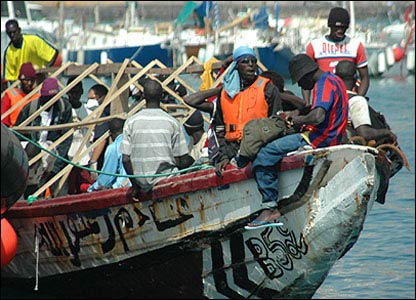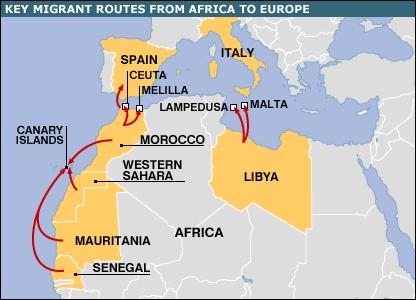geography
coastlines
islands
Sardinia, Sicily, Lambedusa (IT)
The Canaries (Sp)

The
Politics of Migration in an Integrating
Southern Europe
Overview
Immigration as a new problem for Southern European states
Traditionally,
Southern European countries have been "suppliers" of immigrants
countries to N Europe, US
Late 19th-20th Century Wave of emigrants to the US
Post-war era
guestworkers and a component
of the “reserve army” of labor that fueled post-war economic
reconstruction
also important internal migrations within Southern
European
countries, esp. in agriculture, fishing
Southern European countries have become
destination countries for international migrants
Perceived as "the soft underbelly" of the EU's external borders
Why?
South European "exceptionalism"
i.e., backwardness relative to N Europe
weaker state
controls (of borders and regulation of economy generally)
Geddes
refers to this a higher degree of economic "informality and
irregularity"
in other
words, large black market/gray market economy
Why?
geography
coastlines
islands
Sardinia, Sicily, Lambedusa (IT)
The Canaries (Sp)

BBC pictures
from Tenerife
peninsulas
"island colonies" in N Africa of Ceuta and Melilla

proximity to other poorer and war torn
regions/countries
North Africa
Spain's deal with
Senegal
tourism
colonial ties
agricultural economies
rapid economic development (EU)
domestic labor market changes (natives unwilling to do low status work)
a stark birth rate frontier
low birth rates in South, high birth rates in
neighboring regions
political
culture
"irregurality and informality"
see Table 7.1 for comparison of size of informal
economies of several countries
Italy
immigration as a key issue for the Alleanza Nationale and the Lega Nord
joined Schengendland in 1998
reception centers for migrants
"sponsorship" for migrants (by individuals, businesses)
work contracts (2001)
criminalizing illegal status
EU Shoring
Up the "Ring Fence"
Spain to receive 150 mln Euros to create a "electronic wall"
across its 350 mile coastline